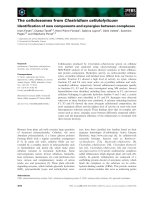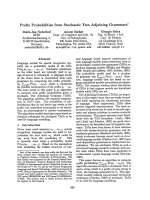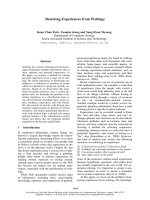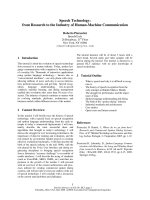Báo cáo khoa học: "Caecal metastasis from breast cancer presenting as intestinal obstruction" doc
Bạn đang xem bản rút gọn của tài liệu. Xem và tải ngay bản đầy đủ của tài liệu tại đây (838.32 KB, 5 trang )
BioMed Central
Page 1 of 5
(page number not for citation purposes)
World Journal of Surgical Oncology
Open Access
Case report
Caecal metastasis from breast cancer presenting as intestinal
obstruction
Rashmi Birla*
1
, Kamal Kumar Mahawar
1
, Mavis Orizu
1
,
Muhammad S Siddiqui
2
and Arun Batra
3
Address:
1
Department of General Surgery, University Hospital of Hartlepool, Hartlepool, TS24 9AH, UK,
2
Department Of Pathology, University
Hospital of Hartlepool, Hartlepool, TS24 9AH, UK and
3
Department Of Radiology, University Hospital of Hartlepool, Hartlepool, TS24 9AH, UK
Email: Rashmi Birla* - ; Kamal Kumar Mahawar - ; Mavis Orizu - ;
Muhammad S Siddiqui - ; Arun Batra -
* Corresponding author
Abstract
Background: Gastrointestinal metastsasis from the breast cancer are rare. We report a patient
who presented with intestinal obstruction due to solitary caecal metastasis from infiltrating ductal
carcinoma of breast. We also review the available literature briefly.
Case presentation: A 72 year old lady with past history of breast cancer presented with intestinal
obstruction due to a caecal mass. She underwent an emergency right hemicolectomy. The
histological examination of the right hemicolectomy specimen revealed an adenocarcinoma in
caecum staining positive for Cytokeratin 7 and Carcinoembryonic antigen and negative for
Cytokeratin 20, CDX2 and Estrogen receptor. Eight out of 11 mesenteric nodes showed tumour
deposits. A histological diagnosis of metastatic breast carcinoma was given.
Conclusion: To the best of our knowledge, this is the first case report of solitary metastasis to
caecum from infiltrating ductal carcinoma of breast. Awareness of this possibility will aid in
appropriate management of such patients.
Background
Metastasis from the breast cancer to the gastrointestinal
tract is rare. Presentation of such patients can mimic that
of primary bowel neoplasm and the exact diagnosis is
often only made on detailed immunohistochemical
study. Appropriate management requires the condition to
be kept in mind while dealing with such cases. We report
a lady who presented with intestinal obstruction due to
solitary caecal metastasis from infiltrating ductal carci-
noma of breast. We also review the available literature
briefly.
Case presentation
A 72 year old lady presented to us as an emergency with
abdominal pain, intermittent vomiting and worsening
constipation of a few days duration. She also reported a
significant weight loss over past few months. Her relevant
past history included rheumatoid arthritis and pT1 N0 M0
carcinoma of the right breast, 3 years ago, for which she
underwent wide local excision and axillary node sampling
followed by adjuvant radiotherapy. She was also on Arim-
idex as hormonal therapy. Her general examination was
unremarkable and the abdominal examination revealed a
Published: 9 May 2008
World Journal of Surgical Oncology 2008, 6:47 doi:10.1186/1477-7819-6-47
Received: 21 November 2007
Accepted: 9 May 2008
This article is available from: />© 2008 Birla et al; licensee BioMed Central Ltd.
This is an Open Access article distributed under the terms of the Creative Commons Attribution License ( />),
which permits unrestricted use, distribution, and reproduction in any medium, provided the original work is properly cited.
World Journal of Surgical Oncology 2008, 6:47 />Page 2 of 5
(page number not for citation purposes)
distended abdomen with a suggestion of fullness in the
right iliac fossa.
A computed tomography (CT) scan of the abdomen
showed a caecal mass causing intestinal obstruction (fig-
ure 1). The patient underwent an emergency right hemi-
colectomy and made a satisfactory postoperative recovery.
At 13 months follow up she had no signs of recurrence of
tumour. CT Scan of her chest and abdomen did not show
any visceral metastasis. A Magnetic Resonance Imaging
Scan and Bone Scan with intravenous MBq Tc 99m-HDP
with imaging at 3 hours ruled out bony metastasis. Carci-
noembryonic Antigen (CEA) and Cancer Antigen 15-3
(CA153) levels done 6 monthly in the follow up period
were within normal limits.
The histology of the wide local excision and axillary sam-
pling specimen had revealed a grade 1 infiltrating ductal
carcinoma (Figure 2A and 2B) with no lymphovascular
invasion. The tumour was 11 mm in maximum diameter
and the closest radial margin was 6 mm inferiorly. None
of the thirteen lymph nodes recovered showed any evi-
dence of metastasis. It was positive for both Estrogen and
Progesterone receptors. Expression of HER 2 protein was
negative. There was only focal ductal carcinoma in situ
(DCIS) seen within the tumour.
On histopathological examination of the right hemicolec-
tomy specimen, an ulcerated tumour was identified in the
caecum. Multiple sections from the caecum showed an
adenocarcinoma with tumour cells in nests and groups
with focal cribriform pattern. The tumour extended into
the mucosa, muscle and the subserosa. No transformation
to malignant epithelium was identified in multiple sec-
tions (figure 3A and 3B). Proximal and distal resection
margins were tumour free. Immunohistochemistry
showed positive staining with Cytokeratin (CK) 7 (figure
4A) and CEA (figure 4B) whereas staining with CK20 (fig-
ure 4C), CDX2 (figure 4D) and Estrogen receptor(ER)
were negative. Progesterone receptor (PR) showed equiv-
ocal nuclear staining. Eight out of eleven mesenteric
nodes showed tumour deposits. A histological diagnosis
of metastatic breast carcinoma was made in light of the
histological pattern of the tumour, previous history of
breast cancer, positive immunostaining with CK7 and
CEA and negative with CK20 and CDX2.
Discussion
Breast cancer is the commonest cancer in females in the
western population. Common sites of metastasis are
Photomicrograph A) and B): Primary breast infiltrating ductal carcinomaFigure 2
Photomicrograph A) and B): Primary breast infiltrating ductal
carcinoma.
An axial CT image showing dilated small bowel loops and concentric thickening of caecal wall (arrow heads) close to the ileocaecal junctionFigure 1
An axial CT image showing dilated small bowel loops and
concentric thickening of caecal wall (arrow heads) close to
the ileocaecal junction. Pericolic and ileocolic lymphnodes
are also seen (arrow).
World Journal of Surgical Oncology 2008, 6:47 />Page 3 of 5
(page number not for citation purposes)
lymph nodes, bone, lungs, liver, brain and skin. Metasta-
sis to the gastro intestinal tract, though very rare is known,
and may require surgical intervention [1,2]. In an autopsy
study of 707 patients by Cifuentes and Pickren [3] metas-
tases to the gastrointestinal tract were detected in 16%
cases with breast carcinoma (stomach 10%, small intes-
tine 9%, and large intestine 8%). There have been isolated
case reports of metastasis to rectum [4] and ileocaecal
valve [5].
Although, breast cancer metastases to gastrointestinal
tract usually arise from lobular variety and are usually dis-
seminated on presentation, solitary metastasis from duc-
tal carcinoma to the ileocecal valve is reported [5]. Wai
Lun Law et al [6] have also described a case of scirrhous
colonic metastasis, infiltrative in nature from ductal carci-
noma of the breast. However, to the best of our knowl-
edge, this is the only report of solitary metastasis to the
caecum from infiltrating ductal carcinoma of the breast.
Patients with a history of breast cancer presenting with
anaemia and/or bowel obstruction should be investigated
for possible metastasis to bowel [7].
Establishing the histological origin of adenocarcinoma
i.e. primary or metastatic however can be challenging.
There isn't any single marker available to aid in determin-
ing the primary site in cases of metastatic adenocarcino-
mas, and therefore a combination of markers is often
employed.
Metastatic breast cancers are usually positive for CK 7,
CEA, ER, PR and gross cystic disease fluid protein 15
(GCDFP 15) [2,8]. CK 7 and CEA positivity is non-specific
[5]. However, CK 20 is almost invariably present in gas-
trointestinal tumours and absent in breast carcinomas
[5,9]. JH Lagendijk et al [10] have also observed in their
study that although the immunostaining patterns show a
considerable overlap, the breast carcinomas were typically
positive for GCDFP-15 and often for ER, and negative for
vimentin whereas colonic carcinomas showed prominent
positivity for CEA and CK20, while no staining was seen
for ER and vimentin.
Seog-Yun Park et al [11] have recently proposed a decision
tree and a design of multiple-marker panels using 10
markers (CDX2, CK7, CK20, thyroid transcription factor 1
(TTF-1), CEA, MUC2, MUC5AC, SMAD4, ER, GCDFP-15)
to determine the origin from seven primary sites (colon,
stomach, lung, pancreas, bile duct, breast, ovaries). In
their study, they found the immunostaining profile for
the origin of metastatic adenocarcinomas from the breast
to be GCDFP-15+/TTF-1-/CDX2-/CK7+/CK20- or ER+/
TTF-1-/CDX2-/CK20-/CEA-/MUC5AC- and that of color-
ectal origin to be TTF-1-/CDX2+/CK7-/CK20+ or TTF-1-/
CDX2+/CK7-/CK20-/(CEA+ or MUC2+).
In an interesting case report by Santini D et al, an increase
in Cancer Antigen (CA) 19.9 was used to diagnose ileocae-
cal valve metastasis from breast cancer in an otherwise
asymptomatic patient [12].
Hence positive staining for CK 7 and negative staining for
CK 20 and CDX2 in our patient favours a diagnosis of
metastatic breast carcinoma [2,5,8,9,11].
The original breast cancer was positive for both ER and
PR. The histopathological specimen of caecal tumour after
right hemicolectomy stained negative for ER and equivo-
cal for PR. Such discordance in hormone receptor status
between primary and metastatic breast cancer lesions has
Photomicrograph A) H and E stained slide showing tumour groups in the lamina propria, muscle and fat covered by benign colonic mucosa, B) Tumour cell groups in the wall and in the vesselsFigure 3
Photomicrograph A) H and E stained slide showing tumour
groups in the lamina propria, muscle and fat covered by
benign colonic mucosa, B) Tumour cell groups in the wall
and in the vessels.
World Journal of Surgical Oncology 2008, 6:47 />Page 4 of 5
(page number not for citation purposes)
been noted by other authors [13,14] previously. Lower EE
et al [13] noticed a higher incidence of discordance with
distant metastasis compared to local recurrence.
Heterogeneity in receptor status within a tumour mass has
also been described [15]. There is no consensus on possi-
ble causes but endocrine treatment, variations in tissue
sampling and technical difficulty have been suggested for
the discordance in the receptor status [13,16].
It is important to be aware of the possibility of gastroin-
testinal metastasis from breast as the management may be
different from a primary bowel neoplasm. Metastatic
breast cancer with intestinal involvement may warrant
systemic hormonal or chemotherapy either alone or com-
bined with surgery [17]. In our case, we did not suspect
the lesion to be a caecal metastasis from breast until indi-
cated by histopathology. Also, since the patient was
obstructed, she needed the surgery on emergency basis.
Both these factors precluded any possible preoperative
systemic anti cancer treatment in this patient. An initial
attempt at postoperative adjuvant chemotherapy also had
to be quickly abandoned due to poor patient tolerance.
Bowel surgery in post mastectomy patients who have
undergone Transverse Rectus Abdominis Myocutaneous
(TRAM) flap would need careful preoperative planning of
surgical incision and any possible stoma [6].
There have been interesting case reports in literature, of
metastatic breast cancer presenting with bowel perfora-
tion in patients receiving chemotherapy [18,19] as well as
photomicrograph A) Immunostaining showing CK7 positivity in tumour cell groupsFigure 4
photomicrograph A) Immunostaining showing CK7 positivity in tumour cell groups. B): Immunostaining showing CEA positiv-
ity in tumour cell groups. C): Immunostaining showing CK20 negativity in tumour cell groups. D): Immunostaining for CDX2.
There is positive staining in normal colonic mucosa (single arrow) whereas the tumour beneath the mucosa stains negative
(two arrows).
Publish with BioMed Central and every
scientist can read your work free of charge
"BioMed Central will be the most significant development for
disseminating the results of biomedical research in our lifetime."
Sir Paul Nurse, Cancer Research UK
Your research papers will be:
available free of charge to the entire biomedical community
peer reviewed and published immediately upon acceptance
cited in PubMed and archived on PubMed Central
yours — you keep the copyright
Submit your manuscript here:
/>BioMedcentral
World Journal of Surgical Oncology 2008, 6:47 />Page 5 of 5
(page number not for citation purposes)
those not receiving chemotherapy [20]. Daniel A et al [21]
have reported a case of oesophageal perforation in a
patient with oesophageal metastasis from breast. Careful
evaluation of gastrointestinal tract in patients with
advanced breast cancer receiving chemotherapy may pre-
vent intestinal perforation [19].
Conclusion
Gastrointestinal metastasis from breast carcinoma may
mimic primary bowel neoplasm in presentation. Immu-
nohistochemistry may aid in differentiating between the
two conditions. Accurate diagnosis will help in formulat-
ing a proper management plan. Surgeons should bear this
condition in mind while treating patients with a past his-
tory of breast cancer presenting with bowel obstruction.
List of abbreviations
CK: Cytokeratin; CEA: Carcinoembryonic antigen; ER:
Estrogen receptor; PR: Progesterone receptor; GCDFP:
Gross cystic disease fluid protein; CA: Cancer antigen;
DCIS: Ductal carcinoma in situ; CT: Computed tomogra-
phy; MRI: Magnetic Resonance Imaging; TRAM: Trans-
verse Rectus Abdominis Myocutaneous
Competing interests
The authors declare that they have no competing interests.
Authors' contributions
RB reviewed the literature and wrote the manuscript. KM
conceived the case report and helped with writing of the
manuscript. MO helped in collecting the images. MS was
pathologist on the case, and helped with pathological sec-
tions in the manuscript. AB helped with the radiological
images. All authors read the manuscript and agreed with
it.
Acknowledgements
Written informed consent was obtained from the patient for publication of
this case report and any accompanying images.
References
1. Asch MJ, Wiedel PD, Habif DV: Gastrointestinal metastases
from carcinoma of the Breast: Autopsy study and 18 cases
requiring operative intervention. Arch Surg 1968,
96(5):840-843.
2. Tohfe M, Shami P, Aftimos G, Saade M: Gastrointestinal metas-
tases from breast cancer: a case report. Southern Medical Journal
2003, 96(6):624-625.
3. Cifuentes N, Pickren JW: Metastases from carcinoma of mam-
mary gland: an autopsy study. J Surg Oncol 1979, 11(3):193-205.
4. Bamias A, Baltayiannis G, Kamina S, Fatouros M, Lymperopoulos E,
Agnanti N, Tsianos E, Pavlidis N: Rectal metastases from lobular
carcinoma of the breast: Report of a case and literature
review. Annals of Oncology 2001, 12:715-718.
5. Hsieh P, Yeh C, Chen J, Changchien C: Ileocecal breast carci-
noma metastasis: Letter to the Editor. International Journal of
Colorectal Disease 2004, 19(6):607-608.
6. Law W, Chu K: Scirrhous colonic metastasis from ductal car-
cinoma of the breast. Dis Colon Rectum 2003, 46(10):1424-1427.
7. Michalopoulos A, Papadopoulos V, Zatagias A, Fahantidis E, Aposto-
lidis S, Haralabopoulos E, Netta S, Sasopoulou I, Harlaftis N: Meta-
static breast adenocarcinoma masquerading as colonic
primary:Report of two cases. Techniques in Coloproctology 2004,
8(1):s135-s137.
8. Franceschini G, Manno A, Mulè A, Verbo A, Rizzo G, Sermoneta D,
Petito L, D'alba P, Maggiore C, Terribile D, Masetti R, Coco C: Gas-
tro-intestinal symptoms as clinical manifestation of perito-
neal and retroperitoneal spread of an invasive lobular breast
cancer: report of a case and review of the literature. BMC
Cancer 2006, 6:193.
9. Tot T: The role of cytokeratins 20 and 7 and estrogen recep-
tor analysis in separation of metastatic lobular carcinoma of
the breast and metastatic signet ring cell carcinoma of the
gastrointestinal tract. APMIS 2000, 108(6):467-472.
10. Lagendijk JH, Mullink H, van Diest PJ, Meijer GA, Meijer CJ: Immu-
nohistochemical differentiation between primary adenocar-
cinomas of the ovary and ovarian metastases of colonic and
breast origin: Comparison between a statistical and an intu-
itive approach. Journal of Clinical Pathology 1999, 52:283-290.
11. Seog-Yun Park, Baek-Hee Kim, Jung-Ho Kim, Sun Lee, Kang Gyeong
Hoon: Panels of immunohistochemical markers help deter-
mine primary sites of metastatic adenocarcinoma. Arch Pathol
Lab Med 2007, 131:1561-1567.
12. Santini D, Altomare A, Vincenzi B, Perrone G, Bianchi A, Rabitti C,
Montesarchio V, Esposito V, Baldi A, Tonini G: An increase of CA
19.9 as the first clinical sign of ileocecal valve metastasis
from breast cancer. In Vivo 2006, 20(1):165-168.
13. Lower EE, Glass EL, Bradley DA, Blau R, Heffelfinger S: Impact of
metastatic estrogen receptor and progesterone receptor
status on survival. Breast Cancer Res Treat 2005, 90(1):65-70.
14. Holdaway IM, Bowditch JV: Variation in receptor status
between primary and metastatic breast cancer. Cancer 1983,
52(3):479-485.
15. Osborne CK: Heterogeneity in hormone receptor status in
primary and metastatic breast cancer. Semin Oncol 1985,
12(3):317-326.
16. Jakesz R, Dittrich C, Hanusch J, Kolb R, Lenzhofer R, Moser K, Rainer
H, Reiner G, Schemper M, Spona J, et al.: Simultaneous and
sequential determinations of steroid hormone receptors in
human breast cancer: Influence of intervening therapy. Ann
Surg 1985, 201(3):05-310.
17. Signorelli C, Pomponi-Formiconi D, Nelli F, Francesco Pollera C: Sin-
gle colon metastasis from breast cancer a clinical case
report. Tumori 2005, 91:424-427.
18. Seewaldt V, Cain JM, Greer BE, Tamimi H, Figge DC: Bowel compli-
cations with taxol therapy. J Clin Oncol 1993, 11:1198.
19. Hata K, Kitayama J, Shinozaki M, Komuro Y, Watanabe T, Tak ano T,
Iwase S, Nagawa H: Intestinal perforation due to metastasis of
breast carcinoma, with special Reference to Chemotherapy:
a Case Report. Japanese Journal of Clinical Oncology 2001,
31:162-164.
20. Cornu-Labat G, Ghani A, Smith DJ, McDonald AD, Kasirajan K:
Small-bowel perforation secondary to metastatic carcinoma
of the breast. Am Surg 1998, 64(4):312.
21. Anaya Daniel A, Mujun Yu Riyad Karmy-Jones: Esophageal Perfo-
ration in a Patient With Metastatic Breast Cancer to
Esophagus. Ann Thorac Surg 2006, 81:1136-1138.









